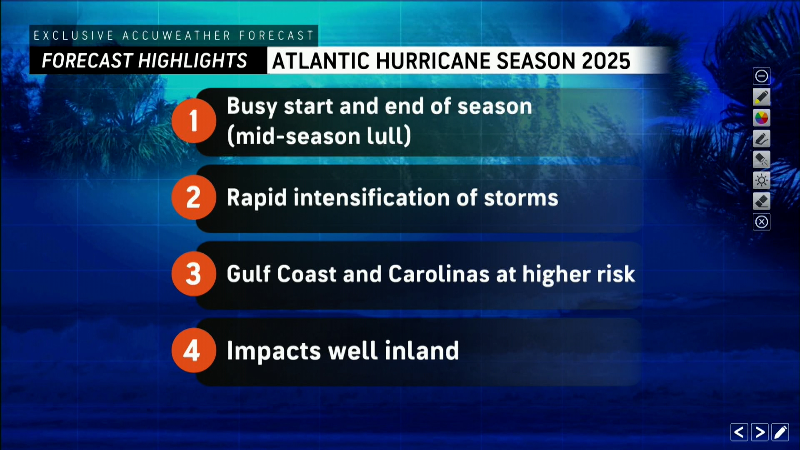Forecasters predict active Atlantic hurricane season. See odds of a hurricane hitting NH

Get ready for another active Atlantic hurricane season, with as many as 17 possible storms and the chance that at least one could have impacts on the Seacoast, experts from Colorado State University said in their initial forecast released Thursday morning.
Of those 17 storms, researchers forecast that nine will become hurricanes. Last year, 18 storms formed, but just five made landfall in the United States, including devastating Hurricanes Helene and Milton. None directly impacted the New England states.
The expected busy season is due to the presence of unusually warm water in the Atlantic Ocean where hurricanes form, along with the predicted absence of an El Niño, which can inhibit hurricane formation.
Colorado State University's outlook is one of several major forecasts for the hurricane season that will publish this spring. AccuWeather's forecast, which came out last week, calls for 13-18 named storms, of which 7-10 will be hurricanes.
Federal forecasters from the National Oceanic and Atmospheric Administration will release their forecast in late May.
When is Atlantic hurricane season 2025?
Hurricane season officially begins June 1, but storms have formed in May in several recent years. The six-month season lasts until November 30.
Will a hurricane impact NH, New England states this year?
According to Colorado State's forecast, New Hampshire and Maine have a a 25% storm chance and 9% hurricane chance. It's about the same as the chance in Connecticut and Rhode Island.
Massachusetts has the highest chance in New England, with a 40% chance that at least one storm could impact it htis season and a 18% chance that it's a hurricane.
Vermont isn't listed in the report.
The early AccuWeather forecast predicts most of this year's storms will impact the Gulf Coast, but it's possible that a tropical storm could hit off the coast of southern Massachusetts and Rhode Island.
Several tropical storms are expected further north off the coast of Maine and Nova Scotia, based on the forecast.
The last hurricane to make landfall in the New England states was in 1991. Since then, there have been a few tropical cyclones that reached land as recently as 2021.
Why are forecasters predicting an active hurricane season?
Colorado State University meteorologist Phil Klotzbach told Paste BN this week that the Atlantic Ocean is "not as warm as it was last year at this time" but that most of the tropical and subtropical Atlantic is still warmer than normal.
A warm Atlantic favors an above-average season, since a hurricane’s fuel source is warm ocean water. Additionally, a warm Atlantic also leads to lower atmospheric pressure and a more unstable atmosphere. Both conditions favor hurricane formation.
"And in the Pacific, we have a La Niña that is likely on its last legs," Klotzbach told Paste BN. La Niña, a natural cooling of ocean water in part of the Pacific, tends to boost Atlantic hurricane activity, while its opposite El Niño tends to suppress Atlantic storms.
Once La Niña fades, "the odds of El Niño appear low for this summer/fall. For example, NOAA's latest forecast only has a 13% chance of El Niño for August-October."
Thus, with neither La Niña or El Niño in charge, "ENSO-neutral" conditions appear to be most likely during the heart of the Atlantic hurricane season. This means that ocean water isn't particularly cool or warm.
"A warmer-than-normal tropical Atlantic and likely ENSO-neutral conditions typically leads to an above-normal hurricane season," Klotzbach said.
Will a major hurricane make landfall in the US in 2025?
Colorado State researchers said there's a 51% chance of a major hurricane making landfall somewhere along the U.S. coastline. The average, based on records from 1880 to 2020, is 43%.
A major hurricane has wind speeds of at least 111 mph.
The chances for a landfall are greater along the Gulf Coast (33%) than they are along the East Coast (26%).
What happened in the 2024 Atlantic hurricane season?
With more than 400 fatalities, 2024 was the nation's deadliest hurricane season since 2005, said National Hurricane Center Director Michael Brennan. It was also the third-costliest on record, after 2017 and 2005.
With a U.S. death toll of at least 241, Hurricane Helene was the continental United States’ deadliest single storm since Hurricane Katrina in 2005, when about 1,400 people died.
Other deadly storms in 2024 included Hurricanes Beryl and Milton, each of which killed over 40 people in the U.S.
In all, 18 named tropical storms and hurricanes formed in 2024, which is above the long-term average of 14. Of those 18 storms, 11 of them strengthened into hurricanes.